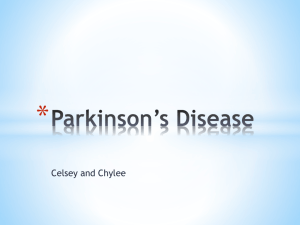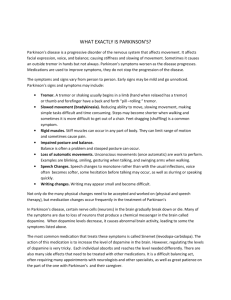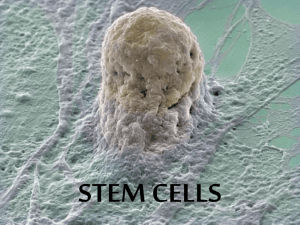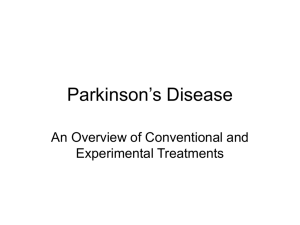Supplemental Discussion 1. Relevance of intrastriatal 6
advertisement
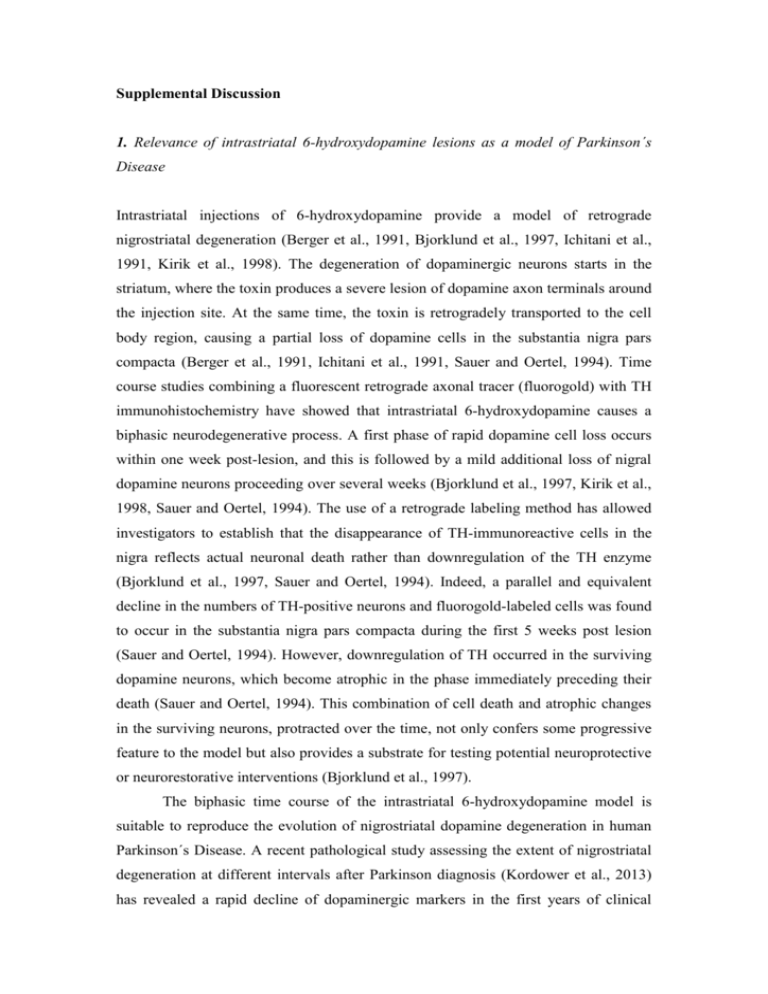
Supplemental Discussion 1. Relevance of intrastriatal 6-hydroxydopamine lesions as a model of Parkinson´s Disease Intrastriatal injections of 6-hydroxydopamine provide a model of retrograde nigrostriatal degeneration (Berger et al., 1991, Bjorklund et al., 1997, Ichitani et al., 1991, Kirik et al., 1998). The degeneration of dopaminergic neurons starts in the striatum, where the toxin produces a severe lesion of dopamine axon terminals around the injection site. At the same time, the toxin is retrogradely transported to the cell body region, causing a partial loss of dopamine cells in the substantia nigra pars compacta (Berger et al., 1991, Ichitani et al., 1991, Sauer and Oertel, 1994). Time course studies combining a fluorescent retrograde axonal tracer (fluorogold) with TH immunohistochemistry have showed that intrastriatal 6-hydroxydopamine causes a biphasic neurodegenerative process. A first phase of rapid dopamine cell loss occurs within one week post-lesion, and this is followed by a mild additional loss of nigral dopamine neurons proceeding over several weeks (Bjorklund et al., 1997, Kirik et al., 1998, Sauer and Oertel, 1994). The use of a retrograde labeling method has allowed investigators to establish that the disappearance of TH-immunoreactive cells in the nigra reflects actual neuronal death rather than downregulation of the TH enzyme (Bjorklund et al., 1997, Sauer and Oertel, 1994). Indeed, a parallel and equivalent decline in the numbers of TH-positive neurons and fluorogold-labeled cells was found to occur in the substantia nigra pars compacta during the first 5 weeks post lesion (Sauer and Oertel, 1994). However, downregulation of TH occurred in the surviving dopamine neurons, which become atrophic in the phase immediately preceding their death (Sauer and Oertel, 1994). This combination of cell death and atrophic changes in the surviving neurons, protracted over the time, not only confers some progressive feature to the model but also provides a substrate for testing potential neuroprotective or neurorestorative interventions (Bjorklund et al., 1997). The biphasic time course of the intrastriatal 6-hydroxydopamine model is suitable to reproduce the evolution of nigrostriatal dopamine degeneration in human Parkinson´s Disease. A recent pathological study assessing the extent of nigrostriatal degeneration at different intervals after Parkinson diagnosis (Kordower et al., 2013) has revealed a rapid decline of dopaminergic markers in the first years of clinical disease, reaching a plateau-like phase by 4-5 years (Kordower et al., 2013). Importantly, the loss of dopaminergic markers in the dorsal putamen appeared complete at post diagnostic intervals of 4-5 years, while spared dopamine fibers could still be detected in ventral and medial striatal regions (Kordower et al., 2013). At the same intervals, the loss of dopamine cell bodies in the substantia nigra (assessed by counting melanine-containing neurons) varied between 33% and 80% (Kordower et al., 2013). In addition to the biphasic time course of nigrostriatal degeneration, the regionally heterogeneous pattern of striatal dopamine denervation and the partial loss of nigral dopamine neurons are reproduced by the intrastriatal 6-hydroxydopamine lesion model used in the present study. Indeed, while virtually complete (~ 99%) dopamine denervation occurred in the dorsolateral striatum (which included the sites of toxin injection), partial (~55%) dopamine denervation occurred in the dorsomedial region (cf. Fig 1). The percentage loss of TH-immunoreactive cells in the ipsilateral substantia nigra pars compacta was approximately 60% (cf. Fig 3). This pattern of nigrostriatal degeneration is quite different from that produced by 6- hydroxydopamine injections in the medial forebrain bundle, causing a very fast and nearly complete loss of both striatal dopaminergic fibers and nigral cell bodies, without any regional specificity (Francardo et al., 2011). 2. Significance of the delayed start-treatment experiment While chronic treatment with PRE-084 promoted functional recovery when started on the day of the lesion, it failed to achieve significant effects when started one week post-lesion. In the main body of the manuscript, we have discussed that the first week post-surgery represents a critical window of opportunities for treatments that boost endogenous plasticity mechanisms in 6-hydroxydopamine-lesioned rodents. Here we would like to discuss the implications of our delayed-start experiment with respect to a potential application of Sigma-1 receptor agonists as a diseasemodifying treatment for Parkinson´s disease. If the first week post-lesion in our mice recapitulates the extent of nigrostriatal degeneration occurring in the first 4-5 years of clinical disease (see above), our data indicate that treatment with Sigma-1 receptor agonists is unlikely to be effective in Parkinson´s patients if started at post-diagnostic intervals longer than 3-4 years. We acknowledge, however, that the extent to which results from laboratory animals sustaining acute lesions can be extrapolated to human Parkinson´s disease remains always uncertain. Indeed, the clinically manifest phase of Parkinson´s disease is preceded by a phase of non-dopaminergic neurodegeneration by many years, possibly impacting on the brain´s neuroregenerative potential. 3. Significance of trophic factor upregulation and signaling pathway activation by PRE-084 treatment. In our study, we found higher protein levels of GDNF, BDNF, pAkt and pERK1/2 in the striatum and the substantia nigra of mice chronically treated with PRE-084 (0.3 mg/kg/day) compared to saline-treated animals (cf. Figs 4 and 5). These molecular effects support the interpretation that, at a regimen producing behavioural restoration, treatment with PRE-084 had promoted endogenous plasticity and defense mechanisms (see main Discussion). Here we would like to review some of the evidence linking the above mentioned molecular changes to the pro-survival and pro-plasticity effects produced by several treatments tested in animal models of Parkinson´s disease. Several studies have shown that the Akt pathway is activated by compounds exerting protective effects on the dopaminergic system (Lim et al., 2008, Sagi et al., 2007, Weinreb et al., 2007, Nair and Olanow, 2008, Yu et al., 2008). This pathway has been shown to mediate not only anti-apoptotic but also neurorestorative events in a murine model of PD (Ries et al., 2006). Moreover, a recent study has shown that activation of the Akt signaling cascade (following rho kinase inhibition) was associated with perikaryal and axonal protection in the MPTP mouse model of Parkinson´s Disease (Tonges et al., 2012). Activation of ERK1/2 signaling in nigral dopamine neurons appears to mediate GDNF-induced neuroprotection against toxic damage both in vitro and in vivo (Lindgren et al., 2008, Onyango et al., 2005, Ugarte et al., 2003, Lindgren et al., 2012). In addition to being beneficial to the nigrostriatal dopamine pathway, trophic factor upregulation and ERK1/2 and Akt pathway activation have the potential to boost plasticity and repair mechanisms in several neural systems. Accordingly, treatment with Sigma-1 receptor agonists has been reported to promote functional recovery in several disease models (reviewed in the main manuscript). In our study, in addition to a pro-dopaminergic effect, treatment with PRE-084 increased striatal serotonin levels (cf. Table 1). Elevated levels of BDNF have been shown to increase the expression of tryptophan hydroxylase 2 in serotonin neurons, while also exerting potent neurotrophic effects on serotonin axon terminals (Mattson et al., 2004). Along with other studies (Ago et al., 2011), these considerations suggest that pharmacological stimulation of Sigma-1 receptors potentiates serotonergic neurotransmission via upregulation of BDNF levels. Importantly, serotonin and BDNF have been described to co-regulate one another, acting as a “dynamic duo” to regulate neuronal survival and synaptic plasticity (Mattson et al., 2004). Since Parkinson´s disease is not only a disorder of dopaminergic neurons, but involves all monoaminergic systems in the brain (Mann and Yates, 1983, Scatton et al., 1983, Halliday et al., 1990), a treatment able to promote neurochemical and synaptic restoration in several monoaminergic pathways (and in other systems as well) may potentially improve both motor and non-motor features in Parkinson´s patients. References Ago, Y., Yano, K., Hiramatsu, N., Takuma, K. & Matsuda, T. 2011. Fluvoxamine enhances prefrontal dopaminergic neurotransmission in adrenalectomized/castrated mice via both 5-HT reuptake inhibition and sigma(1) receptor activation. Psychopharmacology (Berl), 217, 377-86. Berger, K., Przedborski, S. & Cadet, J. L. 1991. Retrograde degeneration of nigrostriatal neurons induced by intrastriatal 6-hydroxydopamine injection in rats. Brain Res Bull, 26, 301-7. Bjorklund, A., Rosenblad, C., Winkler, C. & Kirik, D. 1997. Studies on neuroprotective and regenerative effects of GDNF in a partial lesion model of Parkinson's disease. Neurobiol Dis, 4, 186-200. Francardo, V., Recchia, A., Popovic, N., Andersson, D., Nissbrandt, H. & Cenci, M. A. 2011. Impact of the lesion procedure on the profiles of motor impairment and molecular responsiveness to L-DOPA in the 6-hydroxydopamine mouse model of Parkinson's disease. Neurobiol Dis, 42, 327-40. Halliday, G. M., Blumbergs, P. C., Cotton, R. G., Blessing, W. W. & Geffen, L. B. 1990. Loss of brainstem serotonin- and substance P-containing neurons in Parkinson's disease. Brain Res, 510, 104-7. Ichitani, Y., Okamura, H., Matsumoto, Y., Nagatsu, I. & Ibata, Y. 1991. Degeneration of the nigral dopamine neurons after 6-hydroxydopamine injection into the rat striatum. Brain Res, 549, 350-3. Kirik, D., Rosenblad, C. & Bjorklund, A. 1998. Characterization of behavioral and neurodegenerative changes following partial lesions of the nigrostriatal dopamine system induced by intrastriatal 6-hydroxydopamine in the rat. Exp Neurol, 152, 259-77. Kordower, J. H., Olanow, C. W., Dodiya, H. B., Chu, Y., Beach, T. G., Adler, C. H., et al. 2013. Disease duration and the integrity of the nigrostriatal system in Parkinson's disease. Brain, 136, 2419-31. Lim, J. H., Kim, K. M., Kim, S. W., Hwang, O. & Choi, H. J. 2008. Bromocriptine activates NQO1 via Nrf2-PI3K/Akt signaling: novel cytoprotective mechanism against oxidative damage. Pharmacol Res, 57, 325-31. Lindgren, N., Francardo, V., Quintino, L., Lundberg, C. & Cenci, M. A. 2012. A model of GDNF gene therapy in mice with 6-Hydroxydopamine lesions: time course of Neurorestorative effects and ERK1/2 activation. J Parkinsons Dis, 2, 333-48. Lindgren, N., Leak, R. K., Carlson, K. M., Smith, A. D. & Zigmond, M. J. 2008. Activation of the extracellular signal-regulated kinases 1 and 2 by glial cell line-derived neurotrophic factor and its relation to neuroprotection in a mouse model of Parkinson's disease. J Neurosci Res, 86, 2039-49. Mann, D. M. & Yates, P. O. 1983. Pathological basis for neurotransmitter changes in Parkinson's disease. Neuropathol Appl Neurobiol, 9, 3-19. Mattson, M. P., Maudsley, S. & Martin, B. 2004. BDNF and 5-HT: a dynamic duo in age-related neuronal plasticity and neurodegenerative disorders. Trends Neurosci, 27, 589-94. Nair, V. D. & Olanow, C. W. 2008. Differential modulation of Akt/glycogen synthase kinase-3beta pathway regulates apoptotic and cytoprotective signaling responses. J Biol Chem, 283, 15469-78. Onyango, I. G., Tuttle, J. B. & Bennett, J. P., Jr. 2005. Brain-derived growth factor and glial cell line-derived growth factor use distinct intracellular signaling pathways to protect PD cybrids from H2O2-induced neuronal death. Neurobiol Dis, 20, 141-54. Ries, V., Henchcliffe, C., Kareva, T., Rzhetskaya, M., Bland, R., During, M. J., et al. 2006. Oncoprotein Akt/PKB induces trophic effects in murine models of Parkinson's disease. Proc Natl Acad Sci U S A, 103, 18757-62. Sagi, Y., Mandel, S., Amit, T. & Youdim, M. B. 2007. Activation of tyrosine kinase receptor signaling pathway by rasagiline facilitates neurorescue and restoration of nigrostriatal dopamine neurons in post-MPTP-induced parkinsonism. Neurobiol Dis, 25, 35-44. Sauer, H. & Oertel, W. H. 1994. Progressive degeneration of nigrostriatal dopamine neurons following intrastriatal terminal lesions with 6-hydroxydopamine: a combined retrograde tracing and immunocytochemical study in the rat. Neuroscience, 59, 401-15. Scatton, B., Javoy-Agid, F., Rouquier, L., Dubois, B. & Agid, Y. 1983. Reduction of cortical dopamine, noradrenaline, serotonin and their metabolites in Parkinson's disease. Brain Res, 275, 321-8. Tonges, L., Frank, T., Tatenhorst, L., Saal, K. A., Koch, J. C., Szego, E. M., et al. 2012. Inhibition of rho kinase enhances survival of dopaminergic neurons and attenuates axonal loss in a mouse model of Parkinson's disease. Brain, 135, 3355-70. Ugarte, S. D., Lin, E., Klann, E., Zigmond, M. J. & Perez, R. G. 2003. Effects of GDNF on 6-OHDA-induced death in a dopaminergic cell line: modulation by inhibitors of PI3 kinase and MEK. J Neurosci Res, 73, 105-12. Weinreb, O., Amit, T., Bar-Am, O. & Youdim, M. B. 2007. Induction of neurotrophic factors GDNF and BDNF associated with the mechanism of neurorescue action of rasagiline and ladostigil: new insights and implications for therapy. Ann N Y Acad Sci, 1122, 155-68. Yu, Y., Wang, J. R., Sun, P. H., Guo, Y., Zhang, Z. J., Jin, G. Z., et al. 2008. Neuroprotective effects of atypical D1 receptor agonist SKF83959 are mediated via D1 receptor-dependent inhibition of glycogen synthase kinase-3 beta and a receptor-independent anti-oxidative action. J Neurochem, 104, 94656.

